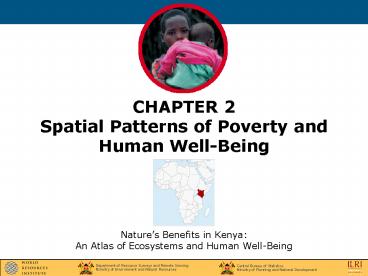CHAPTER 2 Spatial Patterns of Poverty and Human Well-Being PowerPoint PPT Presentation
Title: CHAPTER 2 Spatial Patterns of Poverty and Human Well-Being
1
CHAPTER 2Spatial Patterns of Poverty and Human
Well-Being
- Natures Benefits in KenyaAn Atlas of
Ecosystems and Human Well-Being
2
Dimensions of Well-Being
SECURITY Personal safety Secure resource access Security from disasters FREEDOM OF CHOICE AND ACTION Opportunity to be able to achieve what an individual values doing and being
BASIC MATERIAL FOR GOOD LIFE Adequate livelihoods Sufficient nutritious food Shelter Access to Goods FREEDOM OF CHOICE AND ACTION Opportunity to be able to achieve what an individual values doing and being
HEALTH Strength Feeling well Access to clean air and water FREEDOM OF CHOICE AND ACTION Opportunity to be able to achieve what an individual values doing and being
GOOD SOCIAL RELATIONS Social cohesion Mutual respect Ability to help others FREEDOM OF CHOICE AND ACTION Opportunity to be able to achieve what an individual values doing and being
3
Kenyas Administrative Units Provinces and
Districts, 2003
4
Nyanza Province Poverty Rate
At District Level, 1999
At Location Level, 1999
5
Nyanza Province Poverty Rate at District Level,
1999
6
Nyanza Province Poverty Rate at Location Level,
1999
7
Human Population Density, 1989
8
Human Population Density, 1999
9
Human Population Density
1999
1989
10
Poverty Rate Percentage of Population Below the
Poverty Line, 1999
11
Poverty Density Number of Poor People Per Square
Kilometer, 1999
12
Poverty Gap as a Percent of Poverty Line, 1999
13
Minimum Amount of Kenyan Shillings Needed Per
SquareKilometer Per Month to Close the Poverty
Gap, 1999
14
Average Inequality of Per Capita Expenditures,
1999
15
Percentage of Households With Poor Quality
Housing, 1999
PowerShow.com is a leading presentation sharing website. It has millions of presentations already uploaded and available with 1,000s more being uploaded by its users every day. Whatever your area of interest, here you’ll be able to find and view presentations you’ll love and possibly download. And, best of all, it is completely free and easy to use.
You might even have a presentation you’d like to share with others. If so, just upload it to PowerShow.com. We’ll convert it to an HTML5 slideshow that includes all the media types you’ve already added: audio, video, music, pictures, animations and transition effects. Then you can share it with your target audience as well as PowerShow.com’s millions of monthly visitors. And, again, it’s all free.
About the Developers
PowerShow.com is brought to you by CrystalGraphics, the award-winning developer and market-leading publisher of rich-media enhancement products for presentations. Our product offerings include millions of PowerPoint templates, diagrams, animated 3D characters and more.

